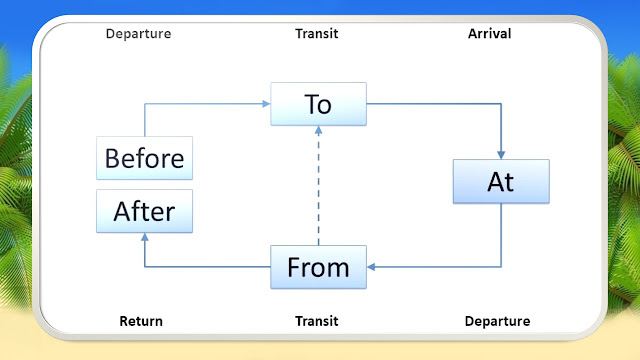 |
| Trip Phases |
Most
trips for tourism purposes may be divided into five distinct phases as
illustrated in the model above:
1. Before: The time leading up to
departure from the traveler’s home.
2. To: The time between
departure from the traveler’s home and arrival at the destination.
3. At: The time spent at the
destination.
4. From: The time between departure
from the destination and return to the traveler’s home.
5. After: The time following return
to the traveler’s home.
A
trip may thus be described as a cycle starting with the before phase and ending
with the after phase. Note that whereas the five trip phases describe periods
of time, the terms departure and arrival describe specific points in
time. Departure is the moment when a person leaves a place, and arrival
is the moment when a person comes to a place. The term transit may be
used to describe the time when a traveler is on the way to or from a
destination. Return is used here to
mean the moment of arrival back home, but the term is also sometimes used to
include the entire homeward journey.
 |
| Trip Phases - Full |
At
some point the after stage of one trip flows over to the before
stage of the next trip, and a new trip cycle begins. The before phase of
one trip may overlap the previous trip cycle, however, in the sense that the
anticipation and planning of one trip may begin already prior to the previous
trip being completed. In the same vein, the after phase may overlap with
the next trip cycle in the sense that the reflections and experiences of one
trip will be carried over into the next. The departure from- and return to a
person's home nevertheless mark clear boundaries between what should be
considered two distinct trips.
The
stippled line in the model above indicates that some trips include more than
one destination, and in such cases traveling from one destination coincides
with the traveling to another destination. The main trip cycle may thus consist
of one or more minor trip cycles. These should be considered partial cycles,
however, because the before and after phase will enclose the entire trip regardless
of whether it involves one or more destinations.
Being
able to distinguish between these phases is important for marketers because
tourism consumers have different needs in the different phases. The tourist
will need to make different types of decisions and deal with different types of
tourism organizations according to where in the trip cycle he or she is.
Different types of decisions means different information requirements. For instance, a
person in the before phase who is trying to decide where to go on the
next holiday will require different information from different information
sources than a person in the at phase who is looking for the nearest
restaurant to have lunch.
Insofar as tourism marketing is about
satisfying the needs of travelers, it is essential to know what needs these
travelers are likely to have when and where. Tourism companies therefore need
to consider which phase their customers are in, and then be sure to meet them
with the appropriate information in the appropriate communication channels at
the appropriate time.


Comments
Post a Comment